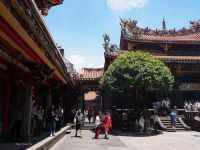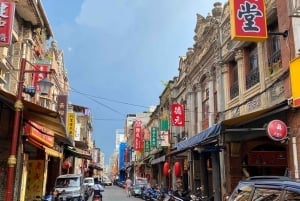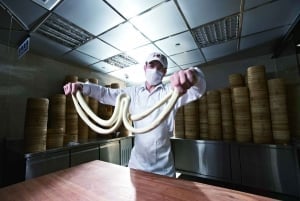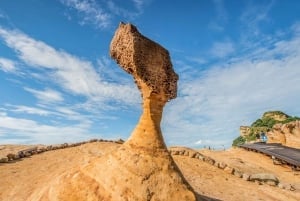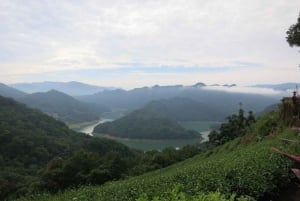Wanhua District
Wanhua District
To get a feel for old Taipei, there's no better place to go than the Wanhua District. This is Taipei's oldest area—one of few places in the city where you can find buildings and small pockets that have escaped the capital's rapid modernization. Known as Bangka in the Taiwanese dialect, Wanhua is found in the city's southwest corner, and is known for its temples, traditional snacks, and shopping. To enjoy all three and a lot more, the best place to go is Ximenting.
Ximenting
If you're into people watching, Ximenting is the place to be. This is the home of subculture and counterculture, not just for Taipei, but for the whole of Taiwan. If you're looking for weird, wonderful, fascinating, and everything in between, this is where you'll find it. The area is so named, (with “Ximen” translating to “West Gate”) for its nearness to the western gate of the old city, and in the early part of the 20th century, Ximenting was built up as Taipei's entertainment and business district by the Japanese colonial rulers at the time.Today, Ximenting is a cramped, crowded hodgepodge of shops of all kinds.Clothing, music, costumes, food, books, magazines, toys, collectibles—if it's alternative, it's here.
Ximenting is also the best place in the city to find street artists and performers, with singers, magicians, and dancers frequently setting up and doing their thing for the crowds. Speaking of which, Ximenting is one of the city's most crowded areas, especially on weekends, with the area drawing several million people per month, locals and tourists alike.
For a taste of Ximenting counterculture, check out Tattoo Street (Hanzhong Lane 50), a small alley a short distance away from exit six of the Ximen MRT station featuring places to get inked and pierced. The alley is home to some of the city's pioneering tattooers who helped bring the art form from the underground to the mainstream in Taiwan, and is worth a look even if you're not into body art. This isn't the only street in the neighborhood named for a particular trade, however. There is also Theater Street (Wuchang Street Section 1), where you'll find movie theaters lined up one after the other. All in all, Ximenting is home to around 20 movie houses, showing everything from western blockbusters to avant garde and art house cinema.
There are also several historic buildings in Ximenting, the most prominent being the Red House Theater (10 Chengdu Road), dating back to 1908. Originally a market, it was converted into a theater in 1945. The first floor has since become an artists' market, and the second floor theater plays host to live performances. The theater building is open Tuesday through Sunday, 11 a.m. to 9:30 p.m.
Just around the corner is Riverside Live House (177 Xining S Rd), where mainstream music acts play frequently. The area around the Red House Theater is home to a number of LGBT clubs where the city's thriving gay scene tends to congregate
Longshan Temple and Night Market
Another iconic area of Wanhua is that surrounding Longshan Temple, one of Taipei's oldest places of worship. The temple itself dates back to 1738, and is dedicated to Buddhist, Taoist, and folk deities though, its primary focus is on Mazu, the goddess of the sea, who protects fishermen and sailors—an all important goddess revered in temples throughout Taiwan for her compassion in guiding the island's Chinese settlers safely across the Taiwan Strait to their new homeland.
Surrounding Longshan Temple are four traditional Taiwanese night markets: Guangzhou Street Night Market, Xichang Street Night Market, Wuzhou Street Night Market, and Huaxi Street Nigh Market. All four are within walking distance from the temple, and are worth taking a slow stroll down to try some food from the many stalls and stands along the way.
Huaxi Street, better known as Snake Alley, is said to be Taipei's oldest tourist night market,and comes with its own kind of fame, or infamy, depending on your point of view. It's so named because it's a place where you can try some snake meat, or even drink snake blood, along with other exotic delicacies such as turtle soup. Once a somewhat seedy area, where unfortunate reptiles would be gutted, skinned, and have their blood drained into shot glasses for tourists, it has undergone somewhat of a cleansing in recent years due to a government campaign to make the area more palatable. Still, Huaxi Street Night market is an excellent place to try tan tsai noodles, oily noodles with stewed meat sauce on top, or thick cuttlefish soup, both Taiwanese delicacies held in high esteem by locals. And of course, there is the temple itself, where the local people come to pray, or bai bai, asking the gods yes-no questions by dropping crescent-shaped pieces of wood on the ground, interpreting the answer by the way the pieces land.
To reach Longshan Temple and the night markets, simply go to Longshan Temple MRT station and follow the bilingual signage. Part of the Huaxi Street Night Market is covered, so you can take it in all its sights, smells, and experiences rain or shine.



